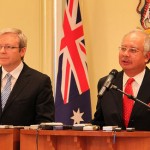Last summer a news headline caught my eye: “US to Malaysia: Stop Human Trafficking Quickly.” Headlines from southeast Asian presses followed, including “Malaysia outcry at US trafficking blacklisting,” and “Malaysia ‘immune’ to U.S. criticism of human trafficking.” When Australian Prime Minister Kevin Rudd met with Malaysian Prime Minister Najib Tun Razak last July, he “praised Malaysia’s energetic efforts to curb human trafficking” ….“despite the fact that Malaysia was just downgraded to Tier 3 from Tier 2 in the Trafficking in Persons (TIP) Report 2009 by the US Department of State.”
These public state-level conversations about trafficking made me curious: Who gave the US the authority to define global trafficking? What authority does the US have in dictating standards for other countries? What happens if “they” (in this case, Malaysian officials) don’t listen? And how much emphasis is placed on “sexual trafficking” in these political conversations?
These questions have led me into a fascinating world of sexual politics — intersecting with domestic and international trafficking policies; heath, human, and labor rights issues; US conservative religious advocacy groups; and US global power. This post will be the first in a series to explain and analyze the contemporary anti-trafficking movement. In this first post, my point is simply to:
- explain the scope and purpose of the Trafficking Victims Protection Act, and
- briefly introduce “demand-side” versus “supply-side” approaches to labor exploitation.
———————————————————————————————————–
Scope and purpose of the Trafficking Victims Protection Act:
In the year 2000, U.S. Congress passed the Trafficking Victims Protection Act designed to address severe forms of trafficking. “Severe forms of trafficking” is defined by the TVPA as:
- sex trafficking in which a commercial sex act is induced by force, fraud, or coercion, or in which the person induced to perform such an act has not attained 18 years of age; or
- the recruitment, harboring, transportation, provision, or obtaining of a person for labor or services, though the use of force, fraud, or coercion for the purpose of subjection to involuntary servitude, peonage, debt bondage, or slavery. [Trafficking in Persons (TIP) Report 2009, Pp. 6-7]
Note that sex trafficking is considered a separate category from labor trafficking, reinforcing the notion that “sex” and “labor” are mutually exclusive. (This, despite two decades of sex work activism arguing for legitimate recognition of sexual labor (e.g., Jenness 1990; Chapkis 1997; Nagel 1997).
Note also that the TVPA lists sex trafficking prior to other forms of trafficking. Just a coincidence? Given the common media conflation of “human trafficking” with “sex trafficking,” as well as President G.W. Bush’s emphasis on the “special evil” of sex trade victims (Lopez, 2006, p. 4), I doubt that it is a coincidence that sex trafficking leads the list.
While people are free to have their opinions on what forms of labor exploitation constitute a “special evil,” in terms of actual numbers the case is clear: the International Labor Organization (the same source cited by the US State Department) estimates that the VAST number of trafficking cases are NOT sex trafficking cases: Approximately 11 out of 12 constitute OTHER forms of labor exploitation (TIP report 2009, p. 8).
State Department monitoring & sanctioning:
Since the passage of the TVPA, the Department of State has been required to provide a report on the status of “foreign governments’ efforts to eliminate severe forms of trafficking in persons” [p. 5, TIP 2009]. This past June (2009) the State Department released its ninth annual Trafficking in Persons report where every country in the world is rated on a scale of 1-3 based on “the extent of government action to combat trafficking.” (TIP report 2009, p. 11). It was in this report that Malaysia was “blacklisted” or moved from “Tier 2 watch list” to “Tier 3.”
Put in academic terms, Professor State Department just gave Malaysia an “F.” So now what?
According to the State Department, “…governments of countries on Tier 3 may be subject to certain sanctions, whereby the U.S. Government may withhold nonhumanitarian, non-trade-related foreign assistance.” Additionally, “governments subject to sanctions would also face U.S. opposition to assistance (except for humanitarian, trade-related assistance) from international financial institutions such as the International Monetary Fund (IMF) and the World Bank.” (TIP report 2009, p. 13). The State Department claims that “(i)mposed sanctions will take effect October 1, 2009.” (TIP report 2009, p. 13).
As of this writing (Oct. 8, 20090 I have not yet seen any evidence that sanctions have been imposed against Malaysia. (Readers: please let me know if you have any news on this).
Demand-side vs. Supply-side strategies:
The US State department assesses foreign anti-trafficking activities based on “the three P’s”: Prosecution, protection, and prevention. The first two are fairly straightforward: does the government in question punish “traffickers” and provide protection for those who are “trafficked?” The third criteria, “prevention” has more room for interpretation. For the US State department, at least at the present moment, “prevention” is tilted toward the “demand side” of the equation — in other words, reducing consumer desire for trafficked goods and services. This includes punishing not just the “traffickers” but the “consumers” of trafficked goods. In the context of the sex industry, this means punishing the “johns” as well as the “pimps.” (e.g., see TIP report 2009, p. 32).
In contrast, a “supply-side” approach to prevention would focus on reducing the economic, social, and cultural conditions that make children and adults vulnerable to abuse and labor exploitation. In this paradigm, interventions would focus on reducing poverty, sexism, racism, and other forms of inequality. Supply-side approaches to prevention would not eliminate the first two “P’s” (Prosecution and protection); it would simply add a social-structural safety net of laws and services (e.g. child labor and welfare laws) to the strategy of finding “bad guys” to punish.
For those trained in sociology, this is a no-brainer: OF COURSE we need to incorporate supply-side approaches. So what’s up with the demand-side emphasis of current US policy?
The current “demand-side” emphasis of all three “P’s” of the TVPA is a reflection of those who initially brought the issue of human trafficking to the US political table. This includes Donna Hughes, a Women Studies professor (trained in genetics) who has spent nearly twenty years as an anti sex-trafficking activist. As an abolitionist (someone who advocates the complete abolition of the sex industry), Hughes applauds the demand-side, punish-the-bad-guys approach to eliminating trafficking and in particular, prostitution (Lopez, p. 4). Hughes applauds former President G.W. Bush for his “crucial” role in this demand-side approach:
“In October 2003, at the United Nations, President Bush called upon world leaders to come to the assistance of victims of the sex trade…..He addressed the demand for victims, by saying, ‘Those who patronize this industry debase themselves and deepen the misery of others’.”
Hughes goes on to say, “by supporting the abolitionist work against the global sex trade, he (Bush) has done more for women and girls than any one other president I can think of. …. Years from now, when the anti-Bush hysteria has died away, I believe he will be recognized as a true advocate for women’s freedom and human rights.” (Hughes, quoted in Lopez, p. 6).
WOW. It’s not every day that you hear a Women Studies professor call President G.W. Bush a “true advocate for women’s freedom and human rights”!
For the second post in this series on the sexual politics of anti-trafficking efforts, click here.
————————————–
The Tiers, as defined by the TVPA:
TIER 1: Countries whose governments fully comply with the Trafficking Victims Protection Act’s (TVPA) minimum standards
TIER 2: Countries whose governments do not fully comply with the TVPA’s minimum standards, but are making significant efforts to bring themselves into compliance with those standards
TIER 2 WATCH LIST: Countries whose governments do not fully comply with the TVPA’s minimum standards, but are making significant efforts to bring themselves into compliance with those standards AND: a) The absolute number of victims of severe forms of trafficking is very significant or is significantly increasing; or b) There is a failure to provide evidence of increasing efforts to combat severe forms of trafficking in persons from the previous year; or c) The determination that a country is making significant efforts to bring themselves into compliance with minimum standards was based on commitments by the country to take additional future steps over the next year
TIER 3: Countries whose governments do not fully comply with the minimum standards and are not making significant efforts to do so.
(Source: TIP report 2009, p. 49)
—————————————————————————–
Bibliography:
- Department of State, United States of America. 2009. “Trafficking in Persons Report, 2009.”
- Chapkis, W. Live Sex Acts: Women performing erotic labor. New York: Routledge.
- Jenness, V. 1990. “From Sex as Sin to Sex as Work: COYOTE and the Reorganization of Prostitution as a Social Problem,” Social Problems.
- Lopez, K.J. 2006. “The new Abolitionist Movement: Donna Hughes on progress fighting sex trafficking.” National Review Online (January 26).
- Nagel, J. (ed). 1997. Whores and Other Feminists. New York: Routledge.

 Recently I was invited to be a guest on Seattle’s NPR station, KUOW (94.9 FM). The topic: “
Recently I was invited to be a guest on Seattle’s NPR station, KUOW (94.9 FM). The topic: “